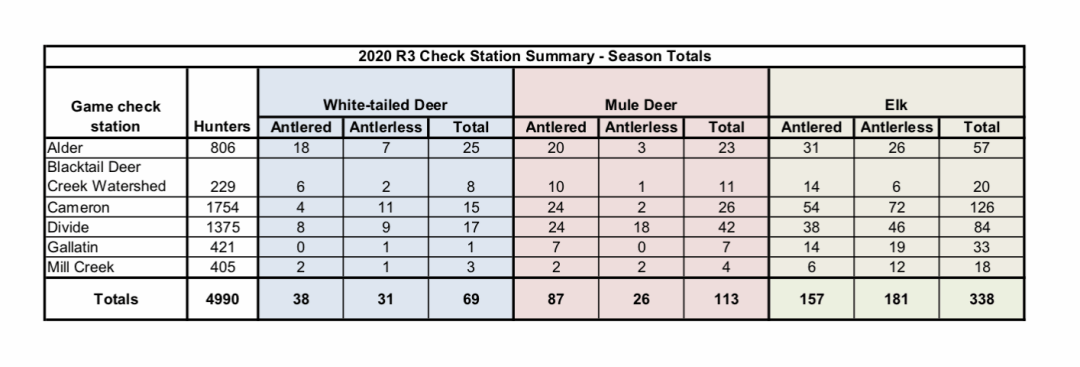General deer, elk hunting season wraps up with mixed hunter success in southwest Montana
Montana’s general deer and elk hunting seasons have ended, and biologists with Montana Fish, Wildlife & Parks saw mixed hunter participation and success in southwest Montana.
Hunter participation and success can be heavily influenced by weather. Severe winter weather over opening weekend limited hunter travel and access in some areas, but significant snowfall didn’t persist over the following weeks enough to cause elk to move to winter range in large numbers. So hunter harvest was lower than average in some areas.
Six game check stations operated during some or all weekends of the general deer and elk hunting season in parts of southwest Montana, including Alder, Blacktail Deer Creek, Cameron, Divide, Gallatin and Mill Creek. At these check stations, biologists met with 4,990 hunters who harvested 69 white-tailed deer, 113 mule deer and 338 elk, among other species.
Biologists use check stations to collect data on hunter numbers, success and wildlife observations, as well as the species, sex and age class of the animals harvested. This supplements data collected through hunter harvest phone surveys, which give a broader perspective on hunter participation and harvest.
Biologists observed below-average harvest of elk and deer at the Ennis check station, which was open both days of each weekend except Oct. 26. This year, 126 elk, 27 mule deer and 15 white-tailed deer were checked at the station. The 1989-2019 averages are 167 elk, 54 mule deer and 25 white-tailed deer.
The number of hunters checked per day at the Gallatin check station has decreased measurably since the unlimited elk permit for Hunting District 310 was removed and the district returned to general license hunting. The average number of hunters checked per day during the unlimited elk permit (2010-17) was 95. The average number of hunters checked per day during general license hunting (2018-20) was 60. In total, FWP staff at the Gallatin check station met with 421 hunters, who harvested one white-tailed deer, seven mule deer and 33 elk.
The Alder check station checked 806 hunters this year, which was similar to 2019 but well below the 8-year average for the check station. Peak hunter participation occurred during the first week of the season, then progressively declined. Elk harvest was about half of average during the first and third weekends, but it was substantially higher than harvest from the past two years over the sixth weekend. In total, the Alder check station saw 806 hunters, who harvested 25 white-tailed deer, 23 mule deer and 57 elk.
Biologists at the Divide check station met with 1,375 hunters, who harvested 17 white-tailed deer, 42 mule deer and 84 elk. The number of hunters here was down 8 percent from 2019 and 10 percent lower than the 10-year average. This year’s hunter success rate of 10.5 percent was 50 percent higher than 2019 and 13 percent higher than the 10-year average. The increase in hunter success is driven mainly by the lower number of hunters and the increased harvest of both mule and white-tailed deer compared to recent years. Elk harvest here was slightly above that of 2019 and on par with the 10-year average. 